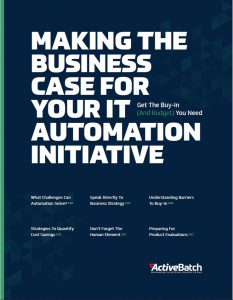Organizations are accelerating the shift to cloud-based software and infrastructure. Multi-cloud environments are increasingly common as organizations focus on digital services and best-of-breed technology. As a result, IT teams are deploying more workloads in the cloud than ever before. A report by Gartner found that 40% of all workloads will be executed in the cloud by 2023, up from 20% in 2020.
Many of these workloads provide direct services for internal and external users. Organizations are pushing IT departments to play a larger role in business processes and services. Gartner expects that 70% of customer experience projects will rely on IT by 2022.
The underlying processes that support digital services need to be elastic and scalable in order to meet demand surges. For example, the more interactions a customer portal receives, the more workloads are going to be triggered. If there aren’t enough servers to run those workloads — if manual provisioning can’t keep pace — then the digital service will grind to a halt.
Automated provisioning solves this problem by spinning-up servers based on demand. This can provide the scalability needed for dynamic resource needs, while improving operational efficiency and reducing cloud spend.
However, a few things need to happen before automating your resource provisioning processes.
Workload Orchestration
The processes that support digital services often have to manage workloads across a variety of systems, especially in cloud-based or hybrid environments. Building these processes in silos doesn’t provide the scalability or reliability that digital services require — connections between point tools (standalone provisioning solutions, for example) are brittle, prone to human error and often rely on time-consuming custom scripts.
The alternative is to deploy a platform-agnostic workload automation solution (WLA) or similar tool. WLA solutions enable users to tie workloads to IT resources and can provide direct integrations and REST API adapters that connect to virtually any endpoint — SaaS, PaaS, IaaS, etc. This makes it possible for IT teams to assemble end-to-end processes that connect infrastructure to the service layer.
Moreover, a platform-agnostic WLA solution can be deployed on-premises or in the cloud. Many WLA solutions are built on a client-server architecture that enables users to deploy execution servers (or job schedulers) in multiple disparate environments.
Unlike other automation technologies, WLA tools can provide a variety of methods for provisioning and deprovisioning servers, giving devops teams greater flexibility to manage end-to-end processes.
Get the buy-in and budget you need for your IT automation initiative
Read five strategies that will help you build a business case for your IT automation goals.
The Basics Of Pairing Workloads To Servers
Workload automation solutions provide a variety of features and capabilities that enable IT teams to manage key resources. The most basic (and perhaps most common) method is to tie a workload to a specific execution server. This is a manual task and is pretty straightforward, though it isn’t scalable — a single server can quickly develop a backlog of workloads, and manual tasks are going to significantly reduce the automation environment’s response time.
To help mediate these drawbacks, WLA tools can provide monitoring features that track CPU and memory usage so that IT knows when an execution server is overloaded. Workflow optimization features can help, too, enabling users to streamline workflows and optimize scheduling to minimize runtimes and prevent bottlenecks.
However, all of these practices require manual processes, which we want to eliminate as much as possible in order to get the scalability the business requires.
Distributing Workloads To Support Automated Provisioning
After you’ve deployed a workload automation tool or extensible scheduler, the next step is to deploy execution servers in the environments where your workloads need to run. Having a distributed architecture enables a new level of workload management (as well as providing high-availability and failover options).
WLA tools can be used to place similar execution servers into groups (sometimes known as generic queues). Instead of assigning a workload to a specific server, the WLA tool can choose which server in the cluster to send a workload to at runtime. This can be accomplished with different types of algorithms based on your team’s needs:
- Workloads can move to the next server once the first one is full
- Workloads can be distributed sequentially across servers
- Workloads can be sent to whichever server is the least used at runtime
By using algorithms to associate execution servers at runtime, IT teams can ensure a higher level of performance and reliability while minimizing manual interventions. Setting up a distributed job scheduling system that can manage workloads automatically is going to set the foundation for automated provisioning.
Common Methods For Automated Server Provisioning
Once you have an automation solution connected to your cloud provider(s), you’re ready to automate your server provisioning. This will likely be done to provide scalability to a generic queue. You’ve deployed the servers needed to support routine demand but need flexibility as your environment grows.
WLA solutions that provide automated provisioning are going to ask you to define parameters for the servers to be provisioned. This includes the machine provider (AWS EC2, Microsoft Azure, VMware, etc.), the authentication method and the retention period, among other options. The retention period refers to how long a server will remain idle before being spun down.
Automated provisioning is generally handled by algorithms, though event-triggers can also be used. Your automation solution will likely use algorithms to analyze historical and real-time data to provision and deprovision additional servers based on expected or unexpected demand. A limit can be set on the number of servers that can be provisioned, usually, though as long as you have set a retention period, idle servers will be spun down.
Additionally, intelligent automation vendors are adding artificial intelligence and machine learning to manage workloads, which can have a significant impact on automated provisioning. For example, AI can be used to analyze data and to determine the optimal placement of workloads within a generic queue. This reduces dispatch latency and optimizes the use of your resources so that fewer servers are ultimately provisioned.
Preparing For Future Challenges
As organizations become more dependent on data and digital solutions, more workloads are going to be managed in complex, heterogeneous environments — across on-prem, private cloud and public cloud. At the same time, the volume of workloads delivering services directly to end-users will continue to increase, driving demand for flexible infrastructure. Gartner lists elasticity as a top-three criteria for over 75% of enterprise technology purchases.
In order to prepare for these challenges, IT teams interested in automated provisioning should first make sure they have a workload automation solution that supports cross-platform processes. This will be key to connecting workloads to the various cloud systems that are being used — or will be used in the coming years.
Ready to simplify your data warehousing with workload automation?
Schedule a demo to watch our experts run jobs that match your business requirements in ActiveBatch. Get your questions answered and learn how easy it is to build and maintain your jobs.

